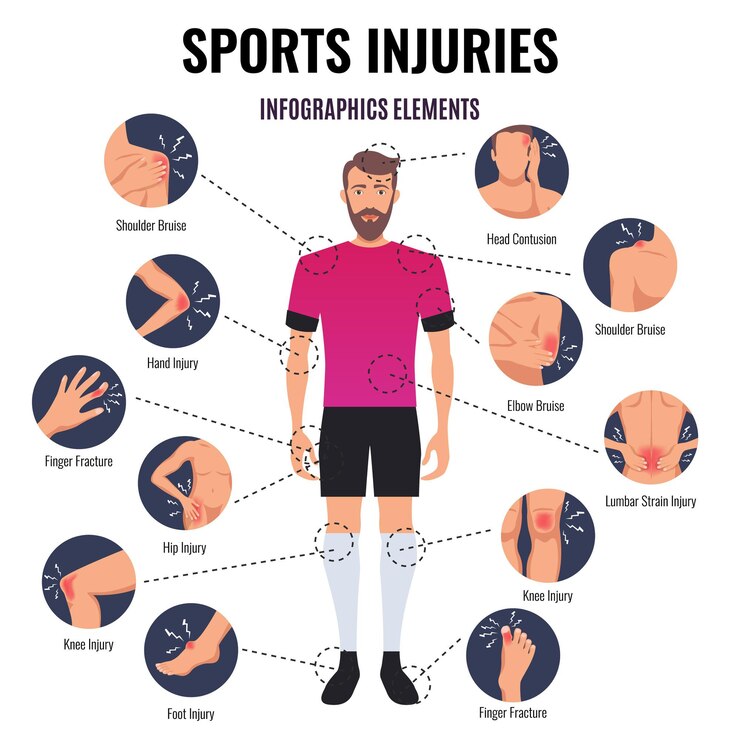Muscle pain is a common issue that can affect individuals of all ages and activity levels. It can range from mild discomfort to severe, debilitating pain. Identifying the type of muscle pain is essential for appropriate treatment and relief. This article discusses the different types of muscle pain, their causes, and effective management strategies.
1. Acute Muscle Pain
Definition:
Acute muscle pain is a sudden onset of discomfort or pain in the muscles, typically resulting from injury, overuse, or strain.
Causes:
-
Injury: Acute muscle pain can occur due to direct trauma, such as a fall or accident.
-
Overuse: Engaging in intense physical activity without proper conditioning can lead to muscle strain.
-
Sudden Movements: Abrupt or awkward movements can cause muscle tears or sprains.
Symptoms:
-
Sharp, intense pain at the site of injury
-
Swelling and bruising
-
Limited range of motion
Treatment:
-
Rest: Allowing the affected muscle to rest and recover is crucial.
-
Ice: Applying ice packs can reduce inflammation and numb the pain.
-
Compression: Using a compression bandage can help manage swelling.
-
Elevation: Keeping the injured area elevated can reduce swelling.
2. Chronic Muscle Pain
Definition:
Chronic muscle pain persists for an extended period, often lasting longer than three months. It may be constant or intermittent and can significantly impact daily activities.
Causes:
-
Medical Conditions: Conditions like fibromyalgia, myofascial pain syndrome, and chronic fatigue syndrome can cause chronic muscle pain.
-
Repetitive Strain: Repeatedly performing the same activity can lead to muscle overuse and chronic pain.
-
Postural Issues: Poor posture can result in chronic muscle tension and pain.
Symptoms:
-
Persistent, dull aching pain
-
Tenderness and stiffness in the muscles
-
Fatigue and sleep disturbances
Treatment:
-
Physical Therapy: Exercises and stretches designed to improve muscle strength and flexibility.
-
Medications: Pain relievers, muscle relaxants, and anti-inflammatory drugs.
-
Lifestyle Changes: Improving posture, incorporating regular exercise, and stress management techniques.
3. Delayed Onset Muscle Soreness (DOMS)
Definition:
DOMS is the muscle pain and stiffness that occur hours to days after unfamiliar or strenuous exercise.
Causes:
-
Eccentric Exercise: Activities involving lengthening of the muscle under tension, such as downhill running or lowering weights.
-
New Exercise Routine: Starting a new workout program or increasing the intensity of an existing one.
Symptoms:
-
Muscle soreness and stiffness, peaking around 24-72 hours post-exercise
-
Reduced range of motion
-
Muscle weakness
Treatment:
-
Active Recovery: Light activities such as walking or gentle stretching can promote blood flow and reduce soreness.
-
Hydration and Nutrition: Staying hydrated and consuming a balanced diet can aid muscle recovery.
-
Massage and Foam Rolling: These techniques can help relieve muscle tightness and improve recovery.
4. Referred Muscle Pain
Definition:
Referred muscle pain occurs when pain is felt in a muscle distant from the actual source of the pain.
Causes:
-
Nerve Impingement: Conditions like herniated discs or pinched nerves can cause pain to radiate to different muscle groups.
-
Internal Organ Issues: Problems with internal organs, such as the heart or kidneys, can cause referred pain in muscles.
Symptoms:
-
Pain in a muscle that is not directly injured or overused
-
Sensations of tingling or numbness
-
Pain that may come and go
Treatment:
-
Addressing the Underlying Cause: Treating the root cause of referred pain, such as spinal adjustments for nerve impingement.
-
Pain Management: Medications, physical therapy, and other modalities to manage the pain.
5. Myofascial Pain
Definition:
Myofascial pain syndrome is a chronic pain disorder caused by sensitive points in the muscles, known as trigger points.
Causes:
-
Muscle Overuse: Repetitive motions or prolonged poor posture can lead to trigger points.
-
Stress: Emotional stress can contribute to muscle tension and trigger points.
Symptoms:
-
Deep, aching pain in the muscles
-
Presence of tender knots or trigger points
-
Pain that worsens with activity or stress
Treatment:
-
Trigger Point Therapy: Techniques such as massage, dry needling, or injections to release trigger points.
-
Stretching and Strengthening: Exercises to improve muscle flexibility and strength.
-
Relaxation Techniques: Stress management strategies, including yoga and meditation.
Understanding the different types of muscle pain, their causes, and effective treatment options can help individuals manage their pain more effectively. By identifying the specific type of muscle pain, appropriate interventions can be implemented to provide relief and improve overall quality of life.




